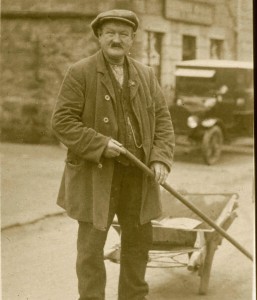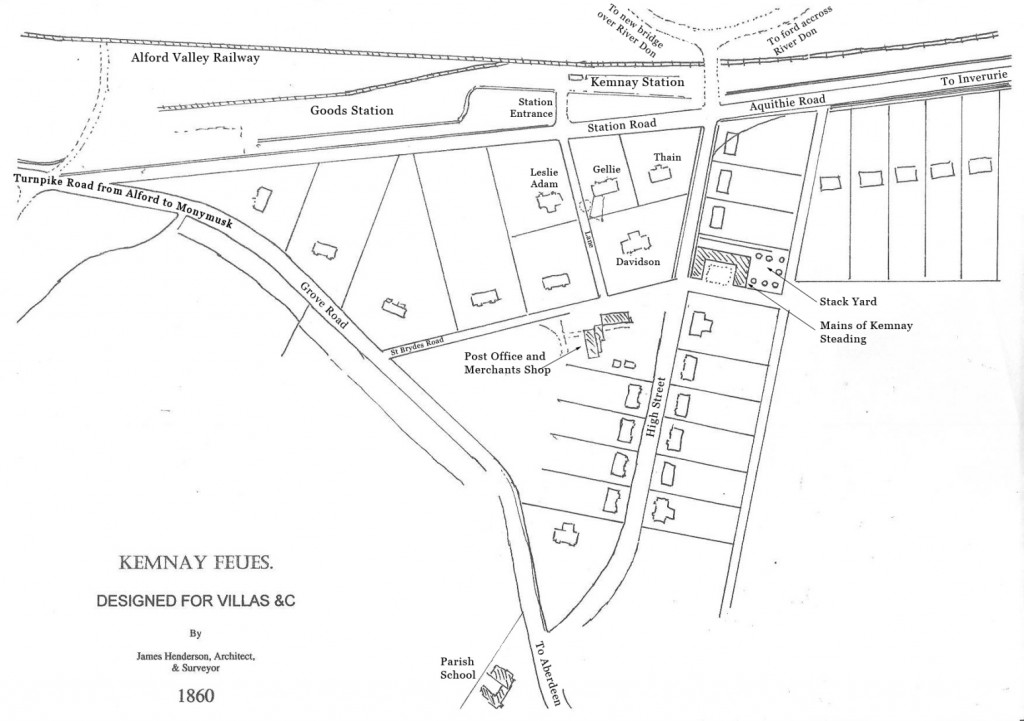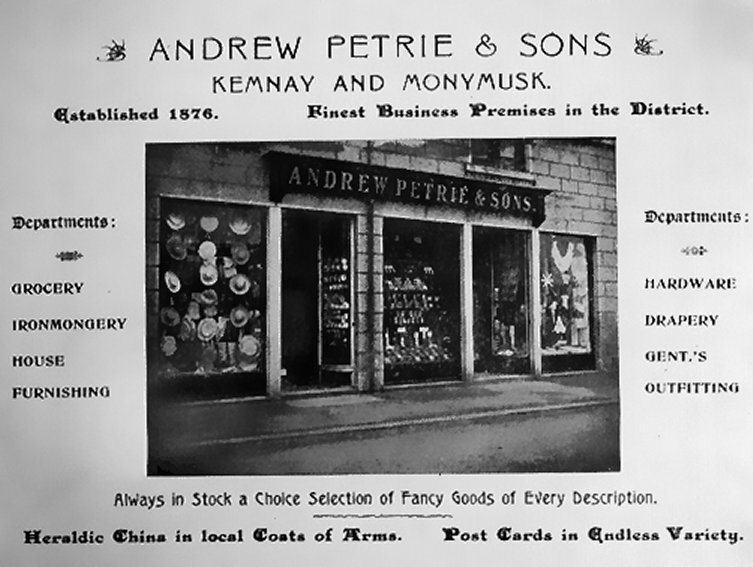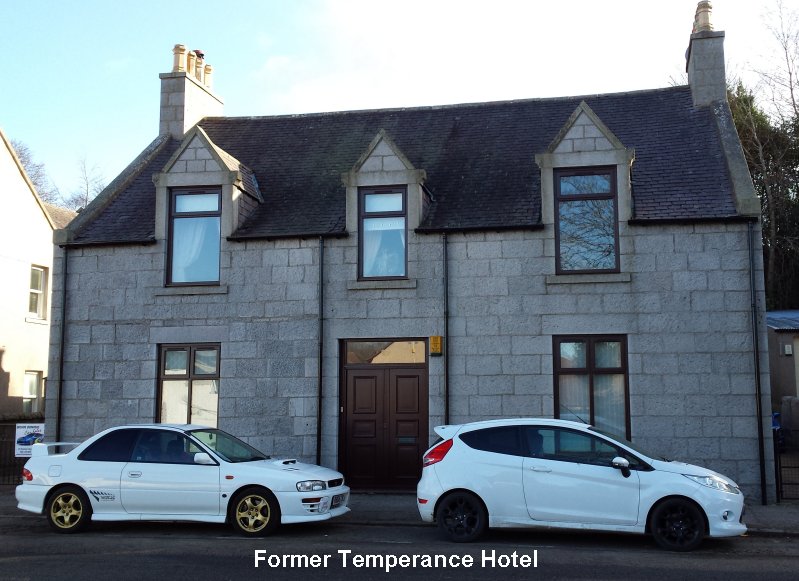It has long been believed that the name ‘Kemnay’ comes from the Gaelic ceann a’ maigh meaning head of the plain (Place names of Scotland, James B. Johnston, ISBN 0 845409 634 5). The beginnings of the settlement remain a mystery but the many archaeological features such as stone circles and Roman encampments nearby indicate a long period of habitation.
The list of buildings made from Kemnay granite sounds like a roll-call of Victorian Confidence. It was used for several bridges in London and Glasgow, the Liver Building in Liverpool, numerous bank headquarters in London, The Forth and Tay railway bridge foundations, piers and approaches; and in Aberdeen the Town House in Castle Street and the extraordinary Broad Street frontage of larger scale extraction Marischal College. More recently it has been used for the construction of the Scottish Parliament in Edinburgh.
The village grew quite rapidly from the 1860s onwards with properties being built along Station Road, Aquithie Road, High Street, Victoria Terrace, Paradise Road, St Bryde’s Road, Kendal Road. Most of the properties were built as tenements housing four families, some of the larger ones housed six families. Four large blocks of houses were built near the quarries to house the large number of incoming workers and these alone housed some 200 people. These were demolished during the 1960s. By the end of the 19th century the pace of development slowed until the late 1920s and during the 1930s, when much of the houses in Riverside Road were erected. The mid 1930s also saw the advent of local authority housing with the houses along Paradise Road being erected in two phases.
Following WWII there was a considerable need for housing and in the first instance this was met by the building of 10 temporary houses, known as prefabs, built where Hillcrest now is. This was followed by another system built type of house – the Cruden Houses – 20 of which were built forming part of what is now Burnett Road and Cairn Road. Kemnay had the honour of having the first Cruden House to be completed in the north of Scotland; it was officially opened on Friday 27th June 1947 at 2.30 p.m. by Major H. R. Spence M.P. These were followed by 6 Cruden house for agricultural workers; four on Donview Road and two on Kendal Road. Over the next twenty five years or so local authority houses were built on Burnett Road, Gordon Road, Wood Gardens, the top half of Cairn Road, Bennachie View, Fraser Place, Fyfe Park, while the prefabs were demolished and replaced with the housing at Hillcrest. During this time there were about two dozen private houses built around the village.
In April 1973 Aberdeen County Council purchased the farm of Alehousewells, extending to 100 acres, as a site for housing and for a new sewage disposal works to serve the village, at a cost of £242,700. The Council later acquired the adjoining Kaimhill Croft. A firm known as Bradley Homes had acquired the land between Paradise Road and the rear of the houses on the south side of Aquithie Road and had started to develop it for housing when they went into liquidation. Aberdeen County Council acquired this land also. To fill the expected large demand for housing, the County Council imported houses in kit form from Scandinavia, and erected them on these sites. In all, some 640 houses were built. In their enthusiasm to erect houses, the Council took their eye off the actual need and it was reported on 6th February 1976 (Inverurie Advertiser) that an offer had been accepted from Scottish Special Housing Association for 80 houses at Kemnay (the scheme at Kembhill Park, which had been built by Laings of London).
Following the completion of the above development in the village the emphasis moved from local authority to private houses.
Barratts purchased part of the Glebe in the mid 1970s and built two bed roomed terraced houses on the lower part of the site with larger detached houses on the remainder of the site, 33 houses in total. In time, the remainder of the site was obtained by Stewart Milne Homes who developed it by erecting 28 houses and this was named Kirkland. More recently, the neighbouring field on Wellbush was acquired jointly by Stewart Milne Homes and Barratts and a development of 105 mixed houses was erected around the Graystone, a glacial remnant, which, according to local folklore was thrown by Auld Hornie from Bennachie at the ‘priest o’ Kemnay’ (WILLIAM CADENHEAD: Flights of Fancy, 1853, The Devil’s Stane). Another landmark which has all but disappeared in this development is the Blethery Well, whose waters once supplied the village. It is commemorated by Cadenhead in his book Ingatherings which was posthumously published in 1905 (The Blethery Well, Kemnay).
The land of the Boat, which had belonged to the Beattie family for many years, was purchased by the firm of John R Craig, Kintore, and in 1986 they built the scheme of 29 houses, which was named Boat Croft. In 1994 the firm completed the development by the building of Craig Lea and Loch Way.
From 1992 onwards part of the farm of Milton has been developed by Malcolm Allan Housebuilders, Kintore, who built a total of 141 houses in two phases. In 1992 the firm also built 41 houses on the remaining land of Kaimhill Croft (Springfield Road).
The period 1997 / 1998 was a very active time for housing developments in Kemnay. R B Farquhar Ltd of Huntly commenced a development of 96 houses on land owned by Aberdeenshire Council and also part of Kirkstyle Farm. The development consisted of an equal mix of houses for rent, low cost houses for sale and normal market value houses. The kaimhill (a glacial remain) behind the croft house of Kaimhill was acquired by Bob Milton who removed it and built 8 houses, naming them Croft Road. In the garden grounds of the Burnett Arms Hotel, a mixed development of 28 houses and flats were built and named Beech Court.
In 2006 a controversial planning application to demolish Bridge House in Bridge Road and erect 10 flats was granted by Aberdeenshire Council despite strong opposition from the community.
Between 2006 and 2013 Barratt Homes submitted for the development of a site in Bogbeth Road, which was initially zoned for 60 houses. Approximately half of the site was subsequently sold to Stuart Milne Homes and by the end of the development a total of 105 houses in total were erected on the site by both developers.
In 2010 / 2011 Deveron Homes commenced work on the erection of a further 54 houses on part of the land at Kirkstyle Farm.
No community has a soul without commerce.
Despite James Henderson’s designs for villas etc., those who took up the building leases had different ideas. In 1863, George Gellie, a twenty three years old supervisor at the quarries obtained a 99 year lease on Station Road, immediately across the road from the then entrance to the station. Rather than building a villa in the middle of the site, Gellie erected a building which housed four tenants and alongside it he erected a building which started out life as a bakery. In the fullness of time this building ended up as the Gushet Neuk Bar/Laird’s Throat. On the other corner of the site, looking on to Station Road, Gellie erected a smaller building, which, over the years has seen life as a dwelling house, tailor’s business, hairdresser, shoemaker and presently Indian restaurant.
What is now the Cooperative store on Station Road started life as a baker and confectioner operated by A. S. Taylor. The original building was erected in the 1930s.
The adjoining plot of land to Gellie’s was leased by James Thain who erected a building which housed six tenants. The ground floor now houses a Chinese takeaway. Some years into the lease the site was subdivided and Andrew Petrie erected the magnificent building which also fronts onto the High Street and was originally a department store consisting of; grocery, ironmongery, house furnishing, gents outfitting, fancy goods as well as a bank agency.
In 1877, Leslie Adam leased the land across the lane from Gellie’s property and erected a similar property to Gellie, only more upmarket, so much so, that Gellie’s tenant, John McDonald, moved his bakery business into the new property, Leslie Place. In the fullness of time the property was developed into the 15 flats of today. McDonald’s place at Gellie’s property was taken by Isaac Wright, also a baker.
In 1901, George B Adams (known as Pie Dod – prior to his move to Station road, he ran a pie shop in the High Street in what is now Lingard’s front shop) leased the adjoining piece of land to Leslie Place and ran a Temperance Hotel. The fine granite building of today fronted a wooden hall at the back in which were held weddings and other similar functions. George Adams sold out to Alexander Henry in 1906 and emigrated to Canada, I think he is buried in Vancouver. Alexander Henry continued to run the hotel until well into the 1920s but profitability tapered off eventually so he concentrated on his bakery and confectionery business. He would have done the baking for his own functions, getting yeast from the baker next door (there were three bakers in the village at that time, all next door to one another), baking eventually took over the business and it operated as a baker/confectioner (under several different proprietors) until 1969 when it changed to a hot food take away but this did not last long. The shop was then taken on to the house and the hall was eventually demolished. For a number of years it has functioned as Brian Downie Car Sales.
St. Andrews, the last plot of land on that side of Station Road was leased by Allan Reid in 1900 and he ran a butcher’s shop. He died in 1922 aged 65 years, having been predeceased by his son, also Allan, who worked with his father and who succumbed to the flu during the 1918 epidemic. The property then passed to William Gerrard who was a van man with John Barron who had a butcher’s business in the High Street. Gerrard had been thinking of starting on his own and Barron got wind of this. When Gerrard returned from his round on the Saturday night he was sacked on the spot. In a small community, such news travels fast and on the Sunday morning some of Gerrard’s friends fixed him up with a van and he was on the road on the Monday morning and took the business from Barron. Over the years the property housed a plumber’s business and a wool shop before the shop was incorporated into the dwelling house.
The building, on Aquithie Road, which houses Cumming Fire and Security, the chipper, Haircraft and Heavenly Beauty was originally built by the Don Cooperative Society in 1887. The business eventually became part of the Northern Cooperative Society and had four departments; butcher and grocery downstairs, drapery and shoes upstairs. It closed down in the mid 1960s and was sold, afterwards being split into the four different units existing today.
The lease on the corner of Kendal Road and Aquithie Road was taken off in 1898 by Thomas Morrison who built the property round the corner which traded as a general merchant, the entrance being on the corner. The present entrance was originally where the dwelling house door was, and there was also a dwelling on Kendal Road. Allegedly, Tommy’s liking for whisky may have led to his downfall because he finished up as street sweeper in the village. It would be good to have Tommy around today tae scold the litter louts an’ those mucket folk that canna clean up after their dogs!

The business was taken over by Peter Strachan whose family moved to Inverurie where they still operate the newsagents and bookseller of that name today. Peter Innes then operated the shop, retiring around 1975 when Douglas Anderson of Mossat took over the business. Today the shop is run under the Costcutter label.
Around the same time, the police station was built across the road, the earlier police station having been what is now Reunion, on the corner of Kendal Road and Paradise Road. Aberdeen County Council built a branch library in part of the police station garden in 1969 and this was replaced with the present building around 1984 – the original building ending up as the showroom at Andrew’s Fireplaces.
The Cooperative store in the Square was the site of the original store and Post Office for the area. William Maitland from Pitmachie took over the lease in 1851
Around 1912, John Pirie, a blacksmith to trade, set up a cycle business on Bridge Road and built a house which he named St Bryde’s View (it looked across the fields to the recently erected Masonic Lodge which sits on top of the hill behind the war memorial). Cycles developed into motor cars and in 1923 he installed a petrol pump. In time he was joined in the business by his son James and the business carried on until the death of James in 1952. The business was sold to Norman Lawrence who developed it into car sales and the rest, as they say, is history. The small forecourt was insufficient for the volume of business and land was acquired across the road in the early 1960s. The field level was considerably below the level of the road, but over time it was made up and provided much needed extra space. The garage on Station Road, which had been operated by J. P. Fraser came on the market around 1960 and was purchased by Norman Lawrence. Later, premises in Paradise Road, which had been operated as a haulage business was acquired and became the spraying department. Management of these separate properties became unwieldy and land was acquired across from the quarry where purpose built premises were erected. The properties in the village were sold: the original site on Bridge Road was acquired by the neighbouring property, Coreen, and the house extended; the car showground on the other side of Bridge Road was acquired by the Jehovah’s Witnesses and Kingdom Hall was erected; the garage on Station Road was acquired by Robert Dow, whilst the property on Paradise Road was acquired by Davie Legge Joinery, who later sold to the Council (Gordon District Council) and it is now laid out as a rear car park for the Village Hall. The business of Lawrence of Kemnay relocated to Port Elphinstone and the land at Aquithie Road lay vacant for several years before reopening as a motor sales area.
To celebrate John Fyfe Ltd. 150th Anniversary of Quarrying at Kemnay, three Artists John Maine, Brad Goldberg and Glen Onwin were commissioned to construct Place Of Origin defined as Art in the landscape, which shares an aesthetic with a Japanese garden – it reflects the larger landscape it sits in, translated as ‘borrowed landscape’. The project was commenced in 1996 and completed in 2006 when it was officially opened by HRH The Duke of Kent. This imposing structure not only provides an elevated viewpoint for Kemnay Quarry and the surrounding area, it also forms a magnificent landscape feature when entering the village from the east.
The population of Kemnay continues to increase, with a development of 54 houses presently being constructed at Fyfe Park. A further 85 houses are scheduled for development during the period 2017 – 2023. The Medical Centre provides a modern comfortable facility for patients and staff but is at full capacity. Land has therefore been identified for the possible construction of a new facility at some future date.
Educational facilities are provided by way of Kemnay Academy and two Primary schools. At the centre of the village is a thriving Village Hall catering for many activities including theatre presentations, film nights, dance and exercises classes and many club events. Other leisure facilities include Kemnay Golf Club with an 18 hole Golf Course, football pitches, cricket pitch, tennis courts, bowling green, Park with play equipment and skate-park and also fishing on the River Don.
To be continued …
Archive Photos
Feedback on General History
Duncan Downie
HISTORY
Norman Edwards



